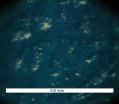(Press-News.org) WASHINGTON, D.C., April 14, 2015 - A team of Finnish scientists has found a new way to examine the ancient art of putting ink to paper in unprecedented 3-D detail. The technique could improve scientists' understanding of how ink sticks to paper and ultimately lead to higher quality, less expensive and more environmentally-friendly printed products.
Using modern X-ray and laser-based technologies, the researchers created a nano-scale map of the varying thickness of toner ink on paper. They discovered that wood fibers protruding from the paper received relatively thin coatings of ink. In general, they also found the toner thickness was dictated mainly by the local changes in roughness, rather than the chemical variations caused by the paper's uneven glossy finish.
The team describes their results in a paper published in the Journal of Applied Physics, from AIP Publishing.
"We believe that this gives new insight, especially on how the topography of paper impacts the ink setting or consolidation," said Markko Myllys, an applied physicist at the University of Jyvaskyla in Finland. "This in turn helps us understand how glossy and non-glossy printed surfaces should be made."
Intricate Ink and Paper Microstructures
To achieve their detailed picture of ink thickness, the researchers first examined the underlying paper with X-ray microtomography, a smaller cousin of the CT scanning technology used in hospitals to produce images of the inside of the body.
To analyze the cyan ink layers, the researchers used two additional technologies: optical profilometry, which bounced a light beam off the surface of the ink to obtain a surface profile, and laser ablation, which zapped away controlled amounts of ink with a laser to determine the ink depth.
Although none of the imaging techniques are themselves new, the researchers were the first to combine all three to achieve a complete, high-resolution 3-D image of the intricate ink and paper microstructures.
The final images resemble a rugged mountain landscape, with the higher peaks generally showing thinner coatings of ink, and the valleys showing thicker pools.
The researchers found the typical ink layer was approximately 2.5 micrometers deep, about 1/40 the thickness of an average sheet of paper, but with relatively large spatial variations between the thickest and thinnest areas.
Knowing how topographical variations affect ink thickness will help the printing industry create more environmentally-friendly and less energy-demanding ink and optimize the size distribution of ink particles, Myllys said. It could also help the papermaking industry design more sustainable paper and packaging, for example from recycled components, while still maintaining the quality needed to make ink stick well. Additionally, the papermaking industry could use the findings to help decide how best to incorporate smart and novel features into paper, Myllys said.
The team believes the imaging methods they used can also be adapted to effectively analyze the thickness variations in other types of thin films, including those found in microelectronics, wear-resistant coatings and solar panels.
"This result can certainly be generalized, and that makes it actually quite interesting," Myllys said. "Thickness variations of thin films are crucial in many applications, but the 3-D analysis has been very difficult or impossible until now."
INFORMATION:
The article, "X-ray microtomography and laser ablation in the analysis of ink distribution in coated paper," is authored by M. Myllys, H. Hakkanen, J. Korppi-Tommola, K. Backfolk, P. Sirvio and J. Timonen. It will be published in the Journal of Applied Physics on April 14, 2015 (DOI: 10.1063/1.4916588). After that date, it can be accessed at: http://scitation.aip.org/content/aip/journal/jap/117/14/10.1063/1.4916588
The authors of this paper are affiliated with the University of Jyvaskyla, the Imatra Research Centre, the Lappeenranta University of Technology and ITMO University.
ABOUT THE JOURNAL
Journal of Applied Physics is an influential international journal publishing significant new experimental and theoretical results of applied physics research. See: http://jap.aip.org
Among a group of more than 320,000 children, intrauterine exposure to gestational diabetes mellitus diagnosed by 26 weeks' gestation was associated with risk of autism spectrum disorders (ASDs), according to a study in the April 14 issue of JAMA. Maternal pre-existing type 2 diabetes was not significantly associated with risk of ASD in offspring.
Exposure of fetuses to maternal hyperglycemia may have long-lasting effects on organ development and function. Previous studies have revealed long-term risks of obesity and related metabolic disorders in offspring of women who ...
Between 2010 and 2013, data breaches of protected health information reported by HIPAA-covered entities increased and involved approximately 29 million records, with most data breaches resulting from overt criminal activity, according to a study in the April 14 issue of JAMA.
Reports of data breaches have increased during the past decade. Compared with other industries, these breaches are estimated to be the most costly in health care; however, few studies have detailed their characteristics and scope. Vincent Liu, M.D., M.S., of the Kaiser Permanente Division of Research, ...
Among patients with atrial fibrillation who filled prescriptions for the anticoagulant dabigatran at Veterans Health Administration sites, there was variability in patient medication adherence across sites, with appropriate patient selection and pharmacist-led monitoring associated with greater adherence to the medication, according to a study in the April 14 issue of JAMA.
Atrial fibrillation is the most common cardiac arrhythmia, affecting more than 3 million patients and necessitating treatment with oral anticoagulation in moderate- to high-risk patients to reduce ...
In a comparison of mechanical prosthetic vs bioprosthetic mitral valves among patients 50 to 69 years of age undergoing mitral valve replacement, there was no significant difference in survival at 15 years, although there were differences in risk of reoperation, bleeding and stroke, according to a study in the April 14 issue of JAMA.
In patients with severe, symptomatic mitral valve disease unsuitable for surgical repair, mitral valve replacement reduces symptoms and improves survival. Bioprosthetic valves (made primarily with tissue) are recommended in patients older ...
PASADENA, Calif., -- Children whose mothers developed gestational diabetes by the 26th week of pregnancy were at increased risk of developing autism later in life, according to a new Kaiser Permanente study published today in the Journal of the American Medical Association.
Researchers examined the electronic health records of more than 322,000 ethnically diverse children born between 28 and 44 weeks at Kaiser Permanente Southern California medical centers between January 1995 and December 2009. They followed the children for an average of 5.5 years and found that those ...
Patients are more likely to take a new type of blood thinner correctly and without missing doses when they are managed by pharmacists, rather than only by doctors or nurses, according to a study co-authored by a researcher at the Stanford University School of Medicine.
Mintu Turakhia, MD, assistant professor of medicine at Stanford, and fellow researchers studied a new treatment for atrial fibrillation, a dangerous heart disorder that increases the risk of stroke and blood clots. The treatment, a drug called dabigatran, is one of a new class of twice-daily oral medications. ...
WASHINGTON D.C., April 14, 2015 - For our modern, technologically-advanced society, in which technology has become the solution to a myriad of challenges, energy is critical not only for growth but also, more importantly, survival. The sun is an abundant and practically infinite source of energy, so researchers around the world are racing to create novel approaches to "harvest" clean energy from the sun or transfer that energy to other sources.
This week in the journal Applied Physics Letters, from AIP Publishing, researchers from the University of Waterloo in Canada ...
Parents who work to instill self-control in their children will see them reap the benefits not only in the short-term but throughout their working life, according to new research in Psychological Science, a journal of the Association for Psychological Science.
The researchers who led the study found that children with high self-control -- who are typically better able to pay attention, persist with difficult tasks, and suppress inappropriate or impulsive behaviors -- are much more likely to find and retain employment as adults, spending 40% less time unemployed than those ...
Instead of shrinking as expected, as part of the normal aging process, the memory center in the brains of seniors maintained their size and, in men, grew modestly after two years in a program that engaged them in meaningful and social activities, new Johns Hopkins Bloomberg School of Public Health-led research suggests.
At the same time, those with larger increases in the brain's volume over two years also saw the greatest improvements on memory tests, showing a direct correlation between brain volume and the reversal of a type of cognitive decline linked to increased ...
WASHINGTON - Gradual and variable change in mental functions that occurs naturally as people age, not as part of a neurological disease such as Alzheimer's disease, is one of the most challenging health issues encountered by older adults, says a new report from the Institute of Medicine. The aging process affects the brain just like any other part of the body. Known as "cognitive aging," the type and rate of change can vary widely among individuals. Some will experience very few, if any, effects, while others may experience changes in their memory, speed of processing ...


